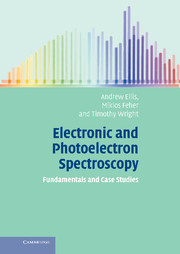Book contents
- Frontmatter
- Contents
- Preface
- List of journal abbreviations
- Part I Foundations of electronic and photoelectron spectroscopy
- Part II Experimental techniques
- Part III Case Studies
- 13 Ultraviolet photoelectron spectrum of CO
- 14 Photoelectron spectra of CO2, OCS, and CS2 in a molecular beam
- 15 Photoelectron spectrum of NO–2
- 16 Laser-induced fluorescence spectroscopy of C3: rotational structure in the 300 nm system
- 17 Photoionization spectrum of diphenylamine: an unusual illustration of the Franck–Condon principle
- 18 Vibrational structure in the electronic spectrum of 1,4-benzodioxan: assignment of low frequency modes
- 19 Vibrationally resolved ultraviolet spectroscopy of propynal
- 20 Rotationally resolved laser excitation spectrum of propynal
- 21 ZEKE spectroscopy of Al(H2O) and Al(D2O)
- 22 Rotationally resolved electronic spectroscopy of the NO free radical
- 23 Vibrationally resolved spectroscopy of Mg+–rare gas complexes
- 24 Rotationally resolved spectroscopy of Mg+–rare gas complexes
- 25 Vibronic coupling in benzene
- 26 REMPI spectroscopy of chlorobenzene
- 27 Spectroscopy of the chlorobenzene cation
- 28 Cavity ringdown spectroscopy of the a1Δ ← X3Σ–g transition in O2
- Appendix A Units in spectroscopy
- Appendix B Electronic structure calculations
- Appendix C Coupling of angular momenta: electronic states
- Appendix D The principles of point group symmetry and group theory
- Appendix E More on electronic configurations and electronic states: degenerate orbitals and the Pauli principle
- Appendix F Nuclear spin statistics
- Appendix G Coupling of angular momenta: Hund's coupling cases
- Appendix H Computational simulation and analysis of rotational structure
- Index
- References
18 - Vibrational structure in the electronic spectrum of 1,4-benzodioxan: assignment of low frequency modes
Published online by Cambridge University Press: 05 June 2012
- Frontmatter
- Contents
- Preface
- List of journal abbreviations
- Part I Foundations of electronic and photoelectron spectroscopy
- Part II Experimental techniques
- Part III Case Studies
- 13 Ultraviolet photoelectron spectrum of CO
- 14 Photoelectron spectra of CO2, OCS, and CS2 in a molecular beam
- 15 Photoelectron spectrum of NO–2
- 16 Laser-induced fluorescence spectroscopy of C3: rotational structure in the 300 nm system
- 17 Photoionization spectrum of diphenylamine: an unusual illustration of the Franck–Condon principle
- 18 Vibrational structure in the electronic spectrum of 1,4-benzodioxan: assignment of low frequency modes
- 19 Vibrationally resolved ultraviolet spectroscopy of propynal
- 20 Rotationally resolved laser excitation spectrum of propynal
- 21 ZEKE spectroscopy of Al(H2O) and Al(D2O)
- 22 Rotationally resolved electronic spectroscopy of the NO free radical
- 23 Vibrationally resolved spectroscopy of Mg+–rare gas complexes
- 24 Rotationally resolved spectroscopy of Mg+–rare gas complexes
- 25 Vibronic coupling in benzene
- 26 REMPI spectroscopy of chlorobenzene
- 27 Spectroscopy of the chlorobenzene cation
- 28 Cavity ringdown spectroscopy of the a1Δ ← X3Σ–g transition in O2
- Appendix A Units in spectroscopy
- Appendix B Electronic structure calculations
- Appendix C Coupling of angular momenta: electronic states
- Appendix D The principles of point group symmetry and group theory
- Appendix E More on electronic configurations and electronic states: degenerate orbitals and the Pauli principle
- Appendix F Nuclear spin statistics
- Appendix G Coupling of angular momenta: Hund's coupling cases
- Appendix H Computational simulation and analysis of rotational structure
- Index
- References
Summary
Concepts illustrated: low frequency vibrations in complex molecules; ab initio calculation of vibrational frequencies; laser-induced fluorescence (excitation and dispersed) spectroscopy; vibrational assignments and Franck–Condon principle.
This Case Study demonstrates some of the subtle arguments that can be employed in assigning vibrational features in electronic spectra. It also provides an illustration of how important structural information on a fairly complex molecule can be extracted. The original work was carried out by Gordon and Hollas using both direct absorption spectroscopy of 1,4-benzodioxan vapour and laser-induced fluorescence (LIF) spectroscopy in a supersonic jet [1]. The direct absorption spectra were of a room temperature sample and were therefore more congested than the jet-cooled LIF spectra. Nevertheless, the direct absorption data provided important information, as will be seen shortly. For the LIF experiments, both excitation and dispersed fluorescence methods were employed (see Section 11.2 for experimental details). Only a few selected aspects of the work by Gordon and Hollas are discussed here; the interested reader should consult the original papers for a more comprehensive account [1, 2].
Possible structures of 1,4-benzodioxan are shown in Figure 18.1. Assuming planarity of the benzene ring, there are three feasible structures that differ in the conformation of the dioxan ring. One possibility is that both C O bonds are displaced above (or equivalently below) the plane of the benzene ring yielding a folded structure with only a plane of symmetry (Cs point group symmetry).
- Type
- Chapter
- Information
- Electronic and Photoelectron SpectroscopyFundamentals and Case Studies, pp. 150 - 156Publisher: Cambridge University PressPrint publication year: 2005



